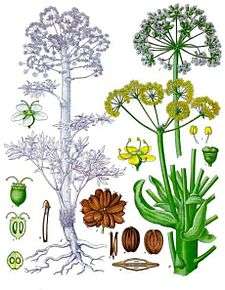Ferula
| Ferula | |
|---|---|
 | |
| Ferula communis | |
| Scientific classification | |
| Kingdom: | Plantae |
| (unranked): | Angiosperms |
| (unranked): | Eudicots |
| (unranked): | Asterids |
| Order: | Apiales |
| Family: | Apiaceae |
| Genus: | Ferula L. |
| Synonyms[1] | |
| |
Ferula (from Latin ferula, "rod") is a genus of about 170 species of flowering plants in the carrot family, native to the Mediterranean region east to central Asia, mostly growing in arid climates. They are herbaceous perennial plants growing to 1–4 m tall, with stout, hollow, somewhat succulent stems. The leaves are tripinnate or even more finely divided, with a stout basal sheath clasping the stem. The flowers are usually yellow, rarely white, produced in large umbels. Many plants of this genus, especially F. communis are referred to as "giant fennel," although they are not fennel in the strict sense.[2][3]

Selected species
- Ferula assa-foetida - Asafoetida
- Ferula caspica
- Ferula communis - Giant fennel
- Ferula conocaula
- Ferula cypria - Cyprus fennel
- Ferula diversivittata
- Ferula foetida
- Ferula gummosa, syn. galbaniflua - Galbanum
- Ferula hermonis
- Ferula karelinii
- Ferula linkii
- Ferula longifolia
- Ferula marmarica
- Ferula moschata, syn sumbul - Muskroot
- Ferula narthex
- Ferula orientalis
- Ferula persica
- Ferula schair
- Ferula szowitziana
- Ferula tingitana
The Roman spice laser or laserpicium probably came from a species of Ferula, either an extinct one or Ferula tingitana, though other identities have been suggested.
Uses
The gummy resin of many species of Ferula is used for medical or culinary purposes:
- Ferula assafoetida is used to make the spice asafoetida, or hing[4]
- Ferula gummosa makes galbanum
- Ferula hermonis makes zallouh, an aphrodisiac [5]
- Ferula persica makes sagapenum
- Ferula moschata makes sumbul
- Ferula tingitana makes "African ammoniacum"
- Silphium was used to make laserpicium
The Romans called the hollow light rod made from this plant a ferula (compare also fasces, judicial birches). Such rods were used for walking sticks, splints, for stirring boiling liquids, and for corporal punishment.
The ferula also shows up in mythological contexts. The main shaft of a thyrsus was traditionally made from this plant, and Prometheus smuggled fire to humanity by hiding it in a ferula as well.
The leaf aqueous-ethanol extract of Feruia foetida has shown antioxidant and antihemolytic activities.[6]
| Wikimedia Commons has media related to Ferula. |
References
- ↑ "Tropicos.org". Retrieved 13 September 2014.
- ↑ Altervista Flora Italiana, genere Ferula
- ↑ Flora of Pakistan, Ferula Linn
- ↑ Plants for a Future, Ferula assa-foetida L., Asafoetida - Devil's Dung. Hing
- ↑ Graham White, National Institute of Medical Herbalists, Ferula hermonis "The Lebanese Viagra" by Stuart FitzSimmons
- ↑ Nabavi SM. Ebrahimzadeh MA. Nabavi SE. Eslami B. Dehpour AA (2011). "Antioxidant and antihaemolytic activities of Ferula foetida regel (Umbelliferae)". European Review for Medical & Pharmacological Sciences. 15 (2): 157–64.